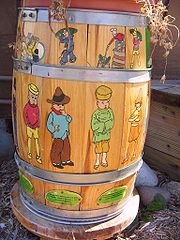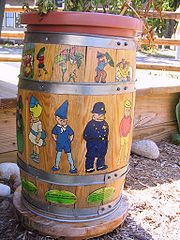
The Teenie Weenies
Encyclopedia

Comic strip
A comic strip is a sequence of drawings arranged in interrelated panels to display brief humor or form a narrative, often serialized, with text in balloons and captions....
created and illustrated by William Donahey
William Donahey
William Donahey was a U.S. cartoonist and creator of The Teenie Weenies, a comic strip about two-inch tall people living under a rose bush....
that first appeared in 1914 in the Chicago Tribune
Chicago Tribune
The Chicago Tribune is a major daily newspaper based in Chicago, Illinois, and the flagship publication of the Tribune Company. Formerly self-styled as the "World's Greatest Newspaper" , it remains the most read daily newspaper of the Chicago metropolitan area and the Great Lakes region and is...
and ran for over 50 years. It consisted of normal-size objects intermingled with tiny protagonist
Protagonist
A protagonist is the main character of a literary, theatrical, cinematic, or musical narrative, around whom the events of the narrative's plot revolve and with whom the audience is intended to most identify...
s. The comic strip characters were two inches tall and lived under a rose bush. They lived with "real world" size materials made from discarded objects like hats, jars, barrels, kegs, and boxes - all of which were gigantic to them.
History

Palmer Cox
Palmer Cox was a Canadian illustrator and author, best known for The Brownies, his series of humorous verse books and comic strips about the mischievous but kindhearted fairy-like sprites. The cartoons were published in several books, such as The Brownies, Their Book...
's The Brownies
The Brownies
The Brownies is a series of publications by Canadian illustrator and author Palmer Cox, based on names and elements from Celtic mythology and traditional highland Scottish stories told to Cox by his grandmother. Illustrations with verse aimed at children, The Brownies was published in magazines and...
and was done in the form of text with a single large picture. Unlike the Brownies where the text was written in verse
Meter (poetry)
In poetry, metre is the basic rhythmic structure of a verse or lines in verse. Many traditional verse forms prescribe a specific verse metre, or a certain set of metres alternating in a particular order. The study of metres and forms of versification is known as prosody...
, Donahey wrote in prose
Prose
Prose is the most typical form of written language, applying ordinary grammatical structure and natural flow of speech rather than rhythmic structure...
.
The Teenie Weenies first appeared in black and white in the women's section of the Chicago Tribune
Chicago Tribune
The Chicago Tribune is a major daily newspaper based in Chicago, Illinois, and the flagship publication of the Tribune Company. Formerly self-styled as the "World's Greatest Newspaper" , it remains the most read daily newspaper of the Chicago metropolitan area and the Great Lakes region and is...
on June 14, 1914. This first story was of the Top Hat house burning down. The comic strip ran as a one panel story with a picture until 1923. It then moved to the comics page as a strip cartoon. Color versions soon appeared in the magazine section of the newspaper printed in rotogravure
Rotogravure
Rotogravure is a type of intaglio printing process; that is, it involves engraving the image onto an image carrier...
.
Donahey drew the comic strip until October 26, 1924 when it was then temporarly discontinued. Donahey's comic characters then went into advertising when the newspaper feature was stopped. It was then a symbol for Reid Murdock. Donahey did advertising for them in The Saturday Evening Post
The Saturday Evening Post
The Saturday Evening Post is a bimonthly American magazine. It was published weekly under this title from 1897 until 1969, and quarterly and then bimonthly from 1971.-History:...
and on their Monarch canned foods line.
Several books of the strip comic characters were also published by Beckley-Cardey Company and Reilly & Lee. In an effort to stimulate new interest in the Teenie Weenies, Reid Murdock and Company in 1927 issued an eight-page pamphlet called The Teenie Weenies: Their Book. On September 24, 1933, the daily comic strip was added again to the Chicago Tribune newspaper. It went then only for about a year and was suspended again on December 2, 1934.
In 1940 and 1941 four of The Teenie Weenies books were reprinted. On May 18, 1941, the Sunday comic strip feature came back permanently. It continued until Donahey's death. During this third time that it was published, two sets of reprints came out. Whittlesy House published three books between 1942 and 1945. Ziff-Davis published two standard-size comic books in 1950 and 1951. Donahey retired in 1969. The last newspaper comic strip episode appeared February 15, 1970. Donahey died February 2 of the same year and never saw the last episode published.
Characters
Donahey's comic strip characters tended to be named after their most prominent characteristics, examples being the Sailor, the Chinese man, the Cook, the Policeman, the Lady of Fashion, the Dunce, the Old Soldier with a Wooden Leg, etc. Each character had a personality accordingly which was not just based on their clothing. According to John D. Taylor, a founding member of the Kansas City Science Fiction and Fantasy Society, there were 45 members of the Teenie Weenie village. Below is Taylor's list of the Teenie Weenies.


Additional reading
- Teenie Weenie Music for Piano, J.Fischer & Brother (1921)
- Down The River With The Teenie Weenies [Jr Ed], Rand-McNally (1940)
- Adventures of the Teenie Weenies [Jr Ed], Rand-McNally (1941)
- Teenie Weenies Under the Rosebush [Jr Ed], Rand-McNally (1941)
- Teenie Weenies [comic #10], Ziff-Davis (1950)
- Teenie Weenies [comic #11], Ziff-Davis (1951)
- Dance of the Teenie Weenies [by Alma Sanders], Halse & Bostick (1916)
Sources
- Cahn, Joseph M., The Teenie Weenies Book: the Life and Art of William Donahey (Green Tiger Press, 1986). ISBN 0-8813803-5-0

